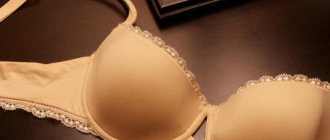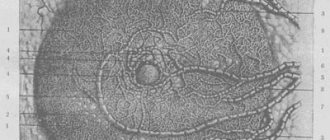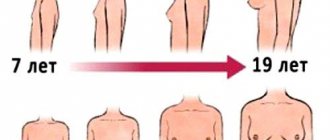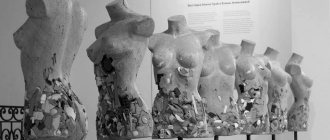Many women have a desire to undergo breast correction with implants. This is due to the causes of congenital underdevelopment of the mammary glands, loss of desired volumes due to breastfeeding or age-related changes.
During the consultation, the plastic surgeon assesses the breast size, general anatomy of the patient and selects the type of access individually for each woman, taking into account her wishes and characteristics.
Submammary access involves installing an implant through an incision in the natural fold under the breast - the submammary fold (submammary). This type of access is indicated if the patient wishes to increase her breast size with implants over 400 g, in connection with the reinstallation of implants to larger ones. In this case, the shape of the nipples and areolas is not adjusted.
Submammary access allows you to install particularly large implants to achieve breast size 4-5. Access is considered the easiest to implement.
The disadvantages of this type of access include two main ones:
- the implant cannot be installed completely under the muscle, and due to this, the lower edge of the implant can be contoured and palpated with thin (less than 1 cm) breast tissue;
- presence of a seam on the chest.
A contraindication is a history of cancer, including breast cancer. Correction is not carried out if the patient has diseases of the endocrine system, mental disorders or infectious diseases. Contraindications are the presence of renal and liver failure, angina pectoris and other heart diseases. Also, the operation is not performed in the presence of blood diseases, including poor clotting. Breast correction with implants is not performed on pregnant and lactating women; at least 6 months must pass after lactation.
Axillary
To create a place for placing an anatomical implant, an incision is made in the axillary region. As a result, the implant is placed under the pectoralis major muscle. In order to avoid serious damage during surgery, doctors use special endoscopic devices and instruments. Since the cross-section is not very large and the view is limited, information about what is happening inside from the camera is transmitted to a special screen, where the doctor can clearly see what he is doing.
The advantage of the method: the scar after the procedure is practically invisible. During the procedure, the surgeon does not touch the glandular tissue, which ensures 100% preservation of the ability to lactation. This type of surgical approach is well suited for thin women whose inframammary fold is not as pronounced.
Disadvantage of the method: the method is quite complicated, since it is more difficult for the doctor to completely exclude nerve damage and be one hundred percent sure that the result is symmetrical cavities for implants. Thus, only relatively small endoprostheses, up to 375 ml in volume, can be installed. Usually, the whole procedure in this case lasts a little longer. The same can be said about the duration of the rehabilitation period.
Periareolar
The essence of this access option is that the section is made in the shape of a semicircle along the border of the skin and areola.
The advantage of the method: when performing augmentation mammoplasty with transareolar access, the scar at the incision site along the edge of the areola is almost invisible. Well suited for cases where women undergo breast lifting in parallel with an increase in the size of the mammary glands.
Disadvantage of the method: it is very difficult for a plastic surgeon to carefully form a cavity for placing an implant. During surgery, there is a high chance that he may damage the nerve that responds to nipple sensitivity. Therefore, wound healing may be more difficult than with other methods. Inflammation with suppuration may occur at the incision site, and over time there is a high risk of cysts and calcifications. Moreover, access through an incision along the edge of the areola can negatively affect the woman’s health, since this may lead to complications associated with future feeding of the child in the form of aseptic mastitis.
Transaxillary access (endoscopic technique)
This access is located in a natural fold in the armpit area and allows you to completely hide the fact of the intervention (the incision quickly becomes invisible).
It is also important that the breast tissue is not affected. Transaxillary access allows you to install implants of any shape in any way.
The main disadvantage of the transaxillary approach is the complexity of execution. Despite this, this option remains preferable.
Anton Igorevich Zakharov performs various plastic surgeries in Moscow, and over the years of practice he has acquired vast experience in this field. Endoscopic breast augmentation (enlargement with transaxillary access) is one of the main specializations of Dr. Zakharov
Submammary
This type of access is the safest and most effective type of breast augmentation. It is used most often in plastic surgery. It is suitable for all types of mammoplasty. The section in this case is made in the inframammary fold.
The advantage of the method: it is well suited for installing any type of large silicone implants. It turns out that the surgeon can easily get to the place where he will need to make a “bed” for the silicone prosthesis.
Disadvantage of this method: after this type of operation, the incision moves slightly and the scar becomes noticeable.
Postoperative period
Breast augmentation surgery via submammary access is performed under general anesthesia and requires a 1-day hospital stay under the supervision of qualified medical personnel. Special sterile patches are applied to the sutures and postoperative compression garments are put on, which require constant wearing for 1 month. Postoperative restrictions apply to physical activity and sports - 2 months, lifting weights over 3 kg - 2 months. Active movements of the arms, including driving, are not recommended for 2 weeks after surgery. In this case, an active motor mode is recommended. It is necessary to consume more proteins, give up bad habits, and apply scar cream 2 weeks after surgery to improve the marks from the manipulations performed (the drug is prescribed exclusively by a plastic surgeon). The final result can be assessed after a few months, but our patients are happy to wear open dresses with a deep neckline and try on new swimsuits after just a couple of months.
Transabdominal
This means that the incision is made on the stomach in the “bikini” area. A very rare method that is used exclusively in cases where tummy tuck needs to be done in parallel with breast augmentation.
Before a surgeon chooses one of the three main types of augmentation mammoplasty access, he takes into account the following factors:
- Patient's wishes
- Bust volume
- Chest volume
- Woman's height
- Distance between mammary glands
- Size and shape of implants
- Availability or absence of necessary medical equipment, etc.
If a modern plastic surgery clinic provides a professional approach to choosing an implant installation approach, it will be easier to guarantee the beautiful appearance of the “new” breast. It is also important to follow all the doctor's instructions. Therefore, the success of the operation mainly depends on the individual characteristics of each patient.
Types of surgical access for breast augmentation and lifting
What is most interesting to patients who decide to undergo breast surgery? First of all, of course, future implants are their size and shape. An equally important question is “how will they be given to me?” and “will the seams be noticeable”?
The type of surgical approach for breast augmentation or lift is one of the main factors in the success of the operation, which largely determines its aesthetic result. ART-Clinic plastic surgeon, Candidate of Medical Sciences, surgeon of the highest category Vadim Sergeevich Bakov talks about the types, advantages and disadvantages of each of the possible approaches:
↑ Surgical access for augmentation mammoplasty
Today, all breast augmentation operations are performed using one of three main options:
Periareolar access. The incision is made along the lower edge of the areola, at the border of pigmented and unpainted skin, which allows the postoperative scar to become almost invisible after some time. The periareolar approach can be used to install any type of breast implant (anatomical or round) both under the muscle and under the mammary gland.
- When choosing this method, the surgeon has the opportunity to perform additional areoloplasty and mastopexy simultaneously with the enlargement. In addition, this approach allows the surgeon to simultaneously correct asymmetry or ptosis of the mammary glands.
- Disadvantages of the periareolar approach include the possibility of changes in nipple sensitivity. However, in the vast majority of cases, it is completely restored over time. If the operation is performed correctly, the mammary gland is not injured and the possibility of breastfeeding remains.
Axillary access. The incision is located in the armpit and runs along the posterior edge of the border of the pectoralis major muscle. Installing an implant through this access does not injure the mammary gland, since its tissues are not affected at all during the operation. In addition, this is the most cosmetic method, in which it is easiest to hide traces of surgery.
- The limitations of the method include its relative inconvenience when installing anatomical implants and increased requirements for the skill of the surgeon and the equipment of the clinic. At the Doctor Plastic clinic, this method is used ONLY with the use of endoscopic technology, since only in this case the axillary approach allows the atraumatic formation of a cavity for the implant, as well as control the risks and eliminate the slightest sources of possible bleeding.
- Serious contraindications for this method of implant installation are the presence of asymmetry of the mammary glands and the need to shift the inframammary fold.
The submammary approach involves an incision in the natural fold under the breast. In the case when the mammary gland and submammary fold are clearly formed and there is no need to displace it, the postoperative scar will be almost invisible.
- Advantages of the method: during mammoplasty, breast tissue is not affected, which completely eliminates their injury. This method is considered the simplest for the surgeon and safest for the patient.
- The only drawback is that such access is not recommended for patients with “girlish” breast shape. If there is no fold under the breast, the scar becomes noticeable. Therefore, we recommend this type of access only to patients whose breast structure allows them to obtain the most cosmetic result after plastic surgery.
It is worth remembering 3 more “exotic” types of surgical access for augmentation mammoplasty. Today they are practically not used due to the increased risk of postoperative complications or unjustified difficulties during the operation:
- Transareolar approach , in which the incision passes across the areola, bypassing the nipple along the lower edge. This type of access allows you to install teardrop-shaped and round implants under the pectoral muscle or mammary gland, but if the size of the areolas is not large enough, the incision may not be long enough. This option is the most traumatic for breast tissue, accompanied by frequent infectious complications and persistent loss of nipple sensitivity. At the same time, the method is characterized by high cosmetic value, since the postoperative suture is invisible on the pigmented skin of the areola.
- Transabdominal access is provided through an incision on the anterior abdominal wall along the bikini line. Breast tissue is not affected during the operation. Such augmentation mammoplasty is performed exclusively during abdominoplasty, as this gives surgeons the opportunity to perform two operations simultaneously through one incision. This is a rather complex option for breast augmentation, which is often accompanied by various complications due to the need to separate the subcutaneous layers over a large area and difficulties in creating a cavity for the implant.
- Umbilical access is provided by an incision in the upper semicircle of the navel. With this type of mammoplasty, the surgeon creates a long tunnel in the tissue through which breast implants are installed. This method is not currently used, because With its help, you can install only implants filled with saline solution, which are practically no longer used today.
↑ Surgical access for mastopexy (breast lift)
Breast lifting and asymmetry correction surgeries require skill and experience from a plastic surgeon. When performing this type of breast surgery, the choice of the type of surgical approach depends on many factors that influence the scope of the intervention: the severity of ptosis, asymmetry, the presence of excess skin, etc.
In the most “successful” option, to eliminate minor ptosis, it is enough to perform augmentation mammoplasty using implant models with a high projection profile.
More noticeable excess skin requires additional incisions to remove excess tissue and create harmonious breast proportions. If the natural volume of the mammary glands is sufficient, then during mastopexy only breast shape correction and subsequent aesthetic skin plastic surgery are performed. If the initial volume of the breast is insufficient, then during the operation an enlargement is performed with the installation of breast implants.
Severe asymmetry of the mammary glands, caused by a significant difference in their volume, is eliminated by partial resection of glandular tissue or installation of implants of various volumes.
The main types of mastopexy, depending on the type of surgical approach, include:
- Periareolar mastopexy. It is performed using two circular incisions: the first along the circumference of the areola, and the second at some distance from the first. Excess skin between the incisions is removed, their edges are joined, and the postoperative scar runs along the border of the areola and unpainted skin. Performed for small to moderate excess skin to correct ptosis and breast asymmetry. Scars with this type of lift become almost invisible 2-6 months after the operation.
- Vertical mastopexy. It is performed using circular incisions, supplemented by vertical ones, which are necessary to excise excess skin in the lower parts of the chest. This type of plastic surgery is used for severe ptosis of the mammary glands, since in this case, simply removing excess skin between circular incisions will not give the desired aesthetic effect - the breast will become flatter, and the outer edge of the incision will be noticeably “gathered.” An additional vertical incision allows you to remove excess skin in the lower parts and give the breast a natural teardrop shape. The incisions, of course, will be much more noticeable than the incisions around the areola, but modern suturing methods allow us to obtain a good aesthetic effect in this case as well. Thin and light vertical scars are not noticeable and do not spoil the overall positive aesthetic effect of the lift.
- To eliminate extreme degrees of breast ptosis, surgeons use additional horizontal incisions under the breast (in the submammary folds), which allows for the most natural result of the operation (this kind of lift is sometimes called an anchor breast lift). The additional scar under the breast is almost invisible after surgery, but it allows you to create a more beautiful and natural breast shape.
The choice of mastopexy method primarily depends on the aesthetic objectives of the operation and the patient’s goals, with preference, of course, being given to the type of surgical approach with minimal postoperative scars.











